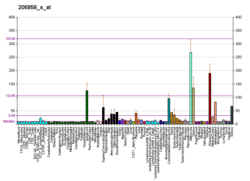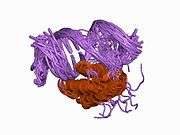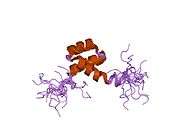HOXC6
Homeobox protein Hox-C6 is a protein that in humans is encoded by the HOXC6 gene.[5][6][7]
Function
This gene belongs to the homeobox family, members of which encode a highly conserved family of transcription factors that play an important role in morphogenesis in all multicellular organisms. Mammals possess four similar homeobox gene clusters, HOXA, HOXB, HOXC and HOXD, which are located on different chromosomes and consist of 9 to 11 genes arranged in tandem. This gene, HOXC6, is one of several HOXC genes located in a cluster on chromosome 12. Three genes, HOXC5, HOXC4 and HOXC6, share a 5' non-coding exon. Transcripts may include the shared exon spliced to the gene-specific exons, or they may include only the gene-specific exons. Alternatively spliced transcript variants encoding different isoforms have been identified for HOXC6. Transcript variant two includes the shared exon, and transcript variant one includes only gene-specific exons.[7]
See also
References
- 1 2 3 GRCh38: Ensembl release 89: ENSG00000197757 - Ensembl, May 2017
- 1 2 3 GRCm38: Ensembl release 89: ENSMUSG00000001661 - Ensembl, May 2017
- ↑ "Human PubMed Reference:".
- ↑ "Mouse PubMed Reference:".
- ↑ McAlpine PJ, Shows TB (Jul 1990). "Nomenclature for human homeobox genes". Genomics. 7 (3): 460. PMID 1973146. doi:10.1016/0888-7543(90)90186-X.
- ↑ Scott MP (Nov 1992). "Vertebrate homeobox gene nomenclature". Cell. 71 (4): 551–3. PMID 1358459. doi:10.1016/0092-8674(92)90588-4.
- 1 2 "Entrez Gene: HOXC6 homeobox C6".
Further reading
- Acampora D, D'Esposito M, Faiella A, Pannese M, Migliaccio E, Morelli F, Stornaiuolo A, Nigro V, Simeone A, Boncinelli E (Dec 1989). "The human HOX gene family". Nucleic Acids Research. 17 (24): 10385–402. PMC 335308
 . PMID 2574852. doi:10.1093/nar/17.24.10385.
. PMID 2574852. doi:10.1093/nar/17.24.10385. - Boncinelli E, Acampora D, Pannese M, D'Esposito M, Somma R, Gaudino G, Stornaiuolo A, Cafiero M, Faiella A, Simeone A (1990). "Organization of human class I homeobox genes". Genome / National Research Council Canada = Génome / Conseil National De Recherches Canada. 31 (2): 745–56. PMID 2576652. doi:10.1139/g89-133.
- Rabin M, Ferguson-Smith A, Hart CP, Ruddle FH (Dec 1986). "Cognate homeo-box loci mapped on homologous human and mouse chromosomes". Proceedings of the National Academy of Sciences of the United States of America. 83 (23): 9104–8. PMC 387083
 . PMID 2878432. doi:10.1073/pnas.83.23.9104.
. PMID 2878432. doi:10.1073/pnas.83.23.9104. - Simeone A, Mavilio F, Acampora D, Giampaolo A, Faiella A, Zappavigna V, D'Esposito M, Pannese M, Russo G, Boncinelli E (Jul 1987). "Two human homeobox genes, c1 and c8: structure analysis and expression in embryonic development". Proceedings of the National Academy of Sciences of the United States of America. 84 (14): 4914–8. PMC 305217
 . PMID 2885844. doi:10.1073/pnas.84.14.4914.
. PMID 2885844. doi:10.1073/pnas.84.14.4914. - Simeone A, Pannese M, Acampora D, D'Esposito M, Boncinelli E (Jun 1988). "At least three human homeoboxes on chromosome 12 belong to the same transcription unit". Nucleic Acids Research. 16 (12): 5379–90. PMC 336773
 . PMID 2898768. doi:10.1093/nar/16.12.5379.
. PMID 2898768. doi:10.1093/nar/16.12.5379. - Corsetti MT, Levi G, Lancia F, Sanseverino L, Ferrini S, Boncinelli E, Corte G (Jan 1995). "Nucleolar localisation of three Hox homeoproteins". Journal of Cell Science. 108 ( Pt 1) (1): 187–93. PMID 7738096.
- Apiou F, Flagiello D, Cillo C, Malfoy B, Poupon MF, Dutrillaux B (1996). "Fine mapping of human HOX gene clusters". Cytogenetics and Cell Genetics. 73 (1-2): 114–5. PMID 8646877. doi:10.1159/000134320.
- Chariot A, Castronovo V, Le P, Gillet C, Sobel ME, Gielen J (Oct 1996). "Cloning and expression of a new HOXC6 transcript encoding a repressing protein". The Biochemical Journal. 319 ( Pt 1) (1): 91–7. PMC 1217739
 . PMID 8870653.
. PMID 8870653. - Kosaki K, Kosaki R, Suzuki T, Yoshihashi H, Takahashi T, Sasaki K, Tomita M, McGinnis W, Matsuo N (Feb 2002). "Complete mutation analysis panel of the 39 human HOX genes". Teratology. 65 (2): 50–62. PMID 11857506. doi:10.1002/tera.10009.
- Ramachandran S, Liu P, Young AN, Yin-Goen Q, Lim SD, Laycock N, Amin MB, Carney JK, Marshall FF, Petros JA, Moreno CS (Jan 2005). "Loss of HOXC6 expression induces apoptosis in prostate cancer cells". Oncogene. 24 (1): 188–98. PMID 15637592. doi:10.1038/sj.onc.1207906.
- Hori Y, Gu X, Xie X, Kim SK (Apr 2005). "Differentiation of insulin-producing cells from human neural progenitor cells". PLoS Medicine. 2 (4): e103. PMC 1087208
 . PMID 15839736. doi:10.1371/journal.pmed.0020103.
. PMID 15839736. doi:10.1371/journal.pmed.0020103. - Kimura K, Wakamatsu A, Suzuki Y, Ota T, Nishikawa T, Yamashita R, Yamamoto J, Sekine M, Tsuritani K, Wakaguri H, Ishii S, Sugiyama T, Saito K, Isono Y, Irie R, Kushida N, Yoneyama T, Otsuka R, Kanda K, Yokoi T, Kondo H, Wagatsuma M, Murakawa K, Ishida S, Ishibashi T, Takahashi-Fujii A, Tanase T, Nagai K, Kikuchi H, Nakai K, Isogai T, Sugano S (Jan 2006). "Diversification of transcriptional modulation: large-scale identification and characterization of putative alternative promoters of human genes". Genome Research. 16 (1): 55–65. PMC 1356129
 . PMID 16344560. doi:10.1101/gr.4039406.
. PMID 16344560. doi:10.1101/gr.4039406. - Zhang X, Hamada J, Nishimoto A, Takahashi Y, Murai T, Tada M, Moriuchi T (2007). "HOXC6 and HOXC11 increase transcription of S100beta gene in BrdU-induced in vitro differentiation of GOTO neuroblastoma cells into Schwannian cells". Journal of Cellular and Molecular Medicine. 11 (2): 299–306. PMID 17488478. doi:10.1111/j.1582-4934.2007.00020.x.
External links
- HOXC6 protein, human at the US National Library of Medicine Medical Subject Headings (MeSH)
This article incorporates text from the United States National Library of Medicine, which is in the public domain.









